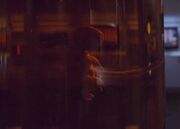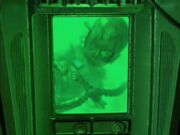m (c) Tag: sourceedit |
m (→Medical investigation of the fetus: lk fix, replaced: Unnamed Sphere-Builders#Sphere-Builder test subject → Sphere-Builder test subject 1) |
||
| Line 17: | Line 17: | ||
The fetus of [[James Tiberius Kirk]] was under constant scan as a new, [[alternate reality]] emerged. Thus, his fetal lifespan was split between two different realities. ({{film|11}}) |
The fetus of [[James Tiberius Kirk]] was under constant scan as a new, [[alternate reality]] emerged. Thus, his fetal lifespan was split between two different realities. ({{film|11}}) |
||
| − | {{bginfo|The term "fetal" was referenced in the final draft script of {{ENT|Harbinger}}, with the [[ |
+ | {{bginfo|The term "fetal" was referenced in the final draft script of {{ENT|Harbinger}}, with the [[Sphere-Builder test subject 1|Sphere-Builder test subject]] described as having "almost fetal-smooth" skin.}} |
==See also == |
==See also == |
||
Revision as of 00:50, 9 October 2017

The fetus of Human-looking mimetic simbiot Sim

A fetal Borg drone
A fetus was an unborn child. Fetuses were technically called "fetuses" until the moment of birth, as evidenced by the fact that Doctor Katherine Pulaski continued to explicitly monitor the "fetal pulse" during delivery. (TNG: "The Child")
The necessity of a womb
Generally, a fetus matured in a single, natural womb until the moment of birth, but there were exceptions. Some fetuses, particularly those of the Borg Collective, were known to have required no natural wombs at all. (TNG: "Q Who"; VOY: "Drone"; ENT: "Similitude") In other extreme cases, it was possible to implant the fetus into another womb. The fetal existence of Keiko O'Brien's second child was deliberately divided, due to an accident, between the wombs of his mother and Kira Nerys. (DS9: "Body Parts", et al.)
Medical investigation of the fetus
As a routine part of the experience of pregnancy, fetuses were exposed to extensive medical scans in order to monitor development of the child against baseline expectations for a species.
Because Deanna Troi's fetus – which eventually was born as the child Ian Andrew Troi – was so unusual, it was under almost constant surveillance by Doctor Pulaski. (TNG: "The Child")
The Doctor's scans of B'Elanna Paris allowed him to construct very elaborate three-dimensional holograms of the fetus that would become Miral Paris. He was also able to predict a birth defect – a deviated spine – and to correct it while the child was still in the womb. Later, B'Elanna accessed these fetal holograms in order to get the computer to suggest additional pre-natal modifications that would de-emphasize the child's Klingon genes. (VOY: "Lineage")
Fetal health of other individuals was known to have been monitored on several other occasions. Samantha Wildman's baby Naomi Wildman was, as Kes once made clear, the subject of The Doctor's regular fetal scans. (VOY: "Dreadnought") One, a Borg created out of a transporter accident, also went through a fetal stage, which Seven of Nine actively monitored. (VOY: "Drone")
The fetus of James Tiberius Kirk was under constant scan as a new, alternate reality emerged. Thus, his fetal lifespan was split between two different realities. (Star Trek)
